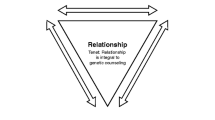Abstract
In this study, we apply an existing medical communication coding system to BRCA1 genetic counseling sessions, describe the session dynamics, and explore variation in session communication. The sample was comprised of 167 members of an identified BRCA1 kindred whose pretest counseling session was audiotaped and coded using Roter's Interaction Analysis System (RIAS). Three certified genetic counselors followed a research protocol that dictated areas to be covered in the counseling session. We found that it was feasible to code long, protocol driven BRCA1 sessions in a quantitative manner without the use of transcripts and capture the dialogue of all session participants. These findings support the use of RIAS in genetic counseling research. Our results indicate that these BRCA1 sessions were predominantly educational in nature with minimal dialogue devoted to psychosocial issues. We found that participant gender, presence of a client companion, and counselor identity influence session communication.
Similar content being viewed by others
References
Baty, B. J., Venne, V. L., McDonald, J., Croyle, R. T., Halls, C., Nash, J. E., et al. (1997). BRCA1 testing: Genetic counseling protocol development and counseling issues. J Genet Counsel, 6, 223–244.
Benkendorf, J., Prince, M., Rose, M. A., De Fina, A., & Hamilton, H. E. (2001). Does indirect speech promote non-directive genetic counseling? Results of a sociolinguistic investigation. Am J Med Genet, 106, 199–207.
Biesecker, B. B., & Peters, K. F. (2001). Process studies in genetic counseling: Peering into the black box. Am J Med Genet (Seminars in Medical Genetics,) 106l, 191–198.
Botkin, J. R., Croyle, R. T., Smith, K. R., Baty, B. J., Lerman, C., Goldgar, D. E., et al. (1996). Commentary: A model protocol for evaluating the behavioral and psychosocial effects of BRCA1 testing. J Natl Cancer Inst, 88, 871–882.
Butow, P. N., & Lobb, E. A. (2004). Analyzing the process and content of genetic counseling in familial breast cancer consultations. J Genet Counsel, 13(5), 403–424.
Goldgar, D. E., Fields, P., Lewis, C. M., Tran, T. D., Cannon-Albright, L. A., Ward, J. H., et al. (1994). A large kindred with 17q-linked breast and ovarian cancer: Genetic, phenotypic, and geneological analysis. J Natl Cancer Inst, 86, 200–209.
Hall, J. A., & Roter, D. L. (2002). Do patients talk differently to male and female physicians? A meta-analytic review. Patient Education and Counseling, 48, 217–224.
Kahana, E., & Kahana, B. (2003). Patient proactivity enhancing doctor-patient-family communication in cancer prevention and care among the aged. Patient Educ Counsel, 50, 67–73.
Kessler, S. (1981). Psychological aspects of genetic counseling: Analysis of a transcript. Am J Med Genet, 8, 137–153.
Kessler, S., & Jacopini, A. G. (1982). Psychological aspects of genetic counseling. II: Quantitative analysis of a transcript of a genetic counseling session. Am J Med Genet, 12, 421–435.
Lerman, C., Croyle, R. T., Tercyak, K. P., & Hamann, H. (2002). Genetic testing: Psychological aspects and implication. J Consult Clin Psychol, 70, 784–797.
Liede, A., Kerzin-Storrar, L., & Craufurd, D. (2000). A method for analyzing videotaped genetic counseling sessions, J Genet Counsel, 9(2), 117–136.
Lobb, E. A., Butow, P. N., Meiser, B., Barratt, A., Gaff, C., Young, M. A., et al. (2003). Women's preferences and consultants' communication of risk in consultations about familial breast cancer: Impact on patient outcomes, J Med Genet, 40, e56.
Lobb, E., Butow, P., Baratt, A., Meiser, B., & Tucker, K. (2005). Differences in individual approaches: Communication in the familial breast cancer consultation and the effect on patient outcomes. J Genet Counsel, 14, 43–53.
Lobb, E. A., Butow, P. N., Barratt, A., Beiser, B., Gaff, C., Young, M. A., et al. (2004). Communication and information-giving in high-risk breast cancer consultations: Influence on patient outcomes. Br J Cancer, 90, 321–327.
Lobb, E. A., Butow, P. N., Meiser, B., Barratt, A., Gaff, C., Young, M. A., et al. (2002). Tailoring communication in consultations with women from high risk breast cancer families. Br J Cancer, 87(5), 502–508.
Michie, S., Bron, F., Bobrow, M., & Marteau, T. (1997). Nondirectiveness in genetic counseling: An empirical study. Am J Hum Genet, 60, 40–47.
Ramirez, A. G. (2003). Consumer-provider communication research with special populations. Patient Educ Counsel, 50, 51–54.
Roter, D. L. (2000a). The enduring and evolving nature of the patient-physician relationship. Patient Educ Counsel, 39, 5–15.
Roter, D. L. (2000b) The medical visit context of treatment decision-making and the therapeutic relationship. Health Expect, 3, 5–15.
Roter, D. L., & Hall, J. A. (2004). Physician gender and patient-centered communications: A critical review of empirical research. Annu Rev Public Health, 25, 497–519.
Roter, D. L., & Hall, J. A. (1993). Doctors talking with patients/patients talking with doctors: Improving communication in medical visits. Westport, CT: Auburn House.
Roter, D. L., & Larson, S. (2002). The Roter interaction analysis system (RIAS): Utility and flexibility for analysis of medical interactions. Patient Educ Counsel, 46, 243–251.
Roter, D. L., Stewart, M., Putnam, S., Lipkin, M., Stiles, W., & Innui, T. (1997). Communication patterns of primary care physicians. J Am Med Assoc, 270, 350–355.
Sarangi, S., Bennert, K., Howell, L., Clarke, A., Harper, P., & Gray, J. (2004).Initiation of reflective frames in counseling for Huntingtons disease predictive testing. J Genet Counsel, 13(2), 135–155.
SPSS, Inc. (2003). SPSS version 12.0.1. Chicago, IL: Author.
Wolraich, M. L., Ablanese, M., Stone, G., Nesbitt, D., Thomson, E., Shymansky, J., et al. (1986). Medical communication behavior system, an interactional analysis system for medical interactions. Med Care, 24, 891–903.
Author information
Authors and Affiliations
Corresponding author
Rights and permissions
About this article
Cite this article
Ellington, L., Roter, D., Dudley, W.N. et al. Communication Analysis of BRCA1 Genetic Counseling. J Genet Counsel 14, 377–386 (2005). https://doi.org/10.1007/s10897-005-3660-3
Issue Date:
DOI: https://doi.org/10.1007/s10897-005-3660-3




